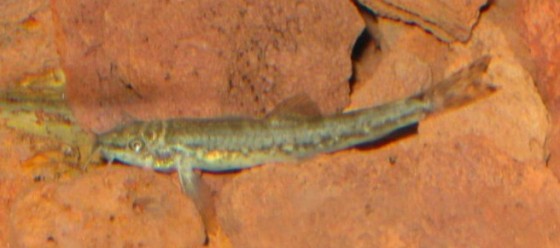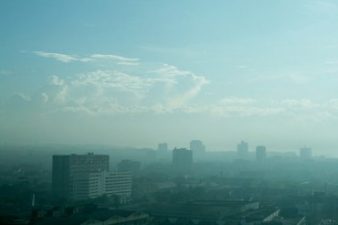 Israeli ecologists are creating habitat to save the severely endangered fish Nemacheilus dori, which measures only two inches.
Israeli ecologists are creating habitat to save the severely endangered fish Nemacheilus dori, which measures only two inches.
The fate of a tiny endangered fish in Israel`s northern region may rest on whether ecologists can create additional aquatic habitat. The Nature and Parks Authority is working to save the fish, a hillstream loach, in Israel’s northern wetlands. The species, Nemacheilus dori, is endemic to Israel. It is found only in one 0.7-hectare wetland nature reserve, located in the north of Israel, at Ein Malkoach.
Nemacheilus dori is quite small, measuring only two inches in adulthood. They are the only fish in this particular wetland area and are notoriously difficult to see with the naked eye. That`s because “their color is very similar to that of the ground and they like to be under stones,” says Dana Milstein, an aquatic ecologist for the Nature and Parks Authority.
The fish is challenged in particular by lack of water flows. The natural spring at Ein Malkoach flows at about 5 cubic meters of water per hour – not enough for the Nemacheilus dori to migrate and seek shelter. That`s why the Nature and Parks Authority built two additional artificial ponds connected to the river.
The Authority now pumps water into those ponds to create flow.
With a rapidly growing populace and extremely limited real estate (Israel is about the size of New Jersey), ecologists need to think creatively to protect increasingly threatened wildlife and bolster diminishing habitat.
Israeli ecologists have fought to save other critically endangered species over the years. For example, two threatened species of sea turtle – Greens and Loggerheads – nest every year on the beaches north of Tel Aviv.
After the number of female turtles migrating to the beaches plummeted, the Nature and Parks Authority built a hatchery. Now, with the help of staff and volunteers who monitor the nests, the numbers are steadily increasing.
Additionally, Israel has fully protected 3% of the Mediterranean region and 20% of the desert region as nature reserves. Special rescue operations for protected species such as the leopard, gazelle, ibex and vulture have been undertaken, including establishment of feeding stations and nesting sites.
The country has even taken a few notes from the Bible in its conservation efforts, breeding and reintroducing animals which historically populated the hills and deserts of the Land of Israel into suitable habitats. Such species include the white oryx, ostrich, Persian fallow deer, and roe deer.
Israel`s major wildlife legislation, the Wildlife Protection Law, was established in 1955. At that time, the law treated “game“ species and “protected animals“ differently. This distinction allowed for widespread sport hunting. As a result,protections were not comprehensive and many wildlife species were overhunted.
But it`s not just hunting that has led to significant wildlife declines: Israel has changed significantly during the last 50 years in ways that have severely impacted animals. Threats to wildlife include habitat loss from housing and infrastructure development, urbanization, appropriation of land for agriculture, pesticide spraying, poisoning and uncontrolled hunting.
In 2010, Israel´s legislature amended the Wildlife Protection Law. The amendment instituted new regulations to control the numerous threats to wildlife. The changes were sweeping. All wildlife are now defined as protected. Sport hunting licenses have been fully revoked. Transferring and abandoning wildlife is prohibited. Poisoning wildlife or trading in fur is punishable as a crime. And stricter penalties are available to enforcement authorities.
An additional reason for the amendment was to implement the requirements of the Convention on International Trade of Endangered Species, to which the country is a signatory.
With the new ponds built by the Nature and Parks Authority, the Nemacheilus dori now swims in flows of 12 cubic meters per hour. That`s more than double the volume of the river before the artificial ponds were built. More creative solutions will be needed as wildlife in Israel feel the pressure from human activity.
Above image via the Israel Nature and Parks Authority.




A well-written and gratifying account of Israel’s efforts to protect all animals, endangered or not, as part of it’s Biblical heritage to preserve life.
The wildlife rehabilitation efforts in Israel are incredible. Great to hear of so much success in these efforts!